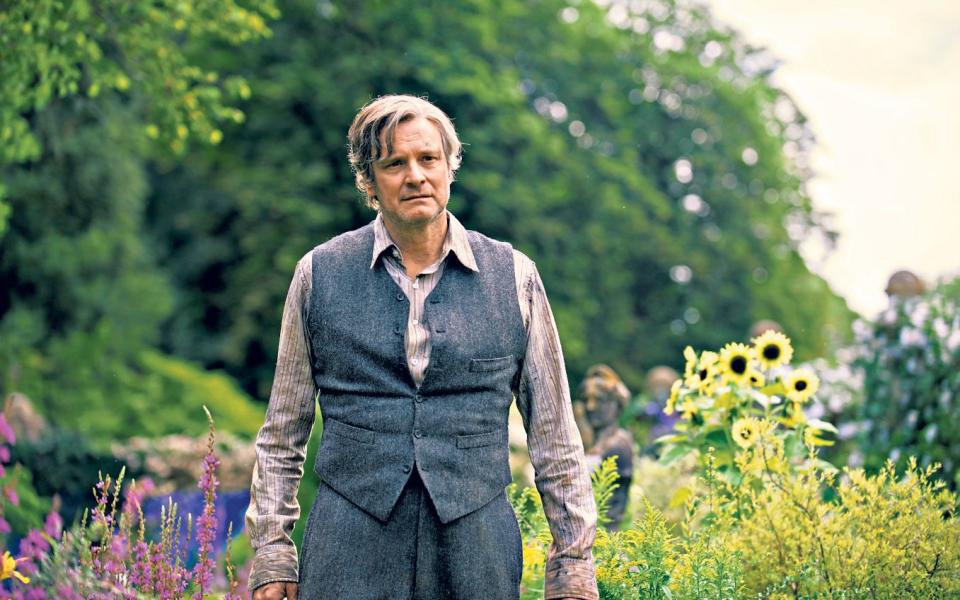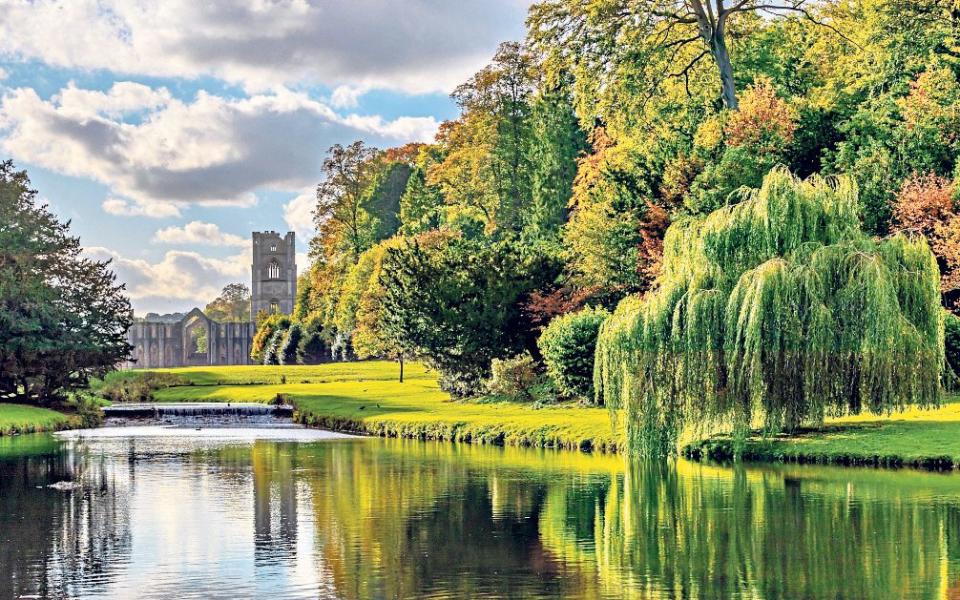Help save the Secret Garden: why a nostalgic trip to Iford Manor is more important than ever

As a child, Marianne Cartwright-Hignett became fixated on The Secret Garden, a 1911 children’s classic by Frances Hodgson Burnett. “It was by far my favourite book. I reread it endlessly because I loved its secret world so much,’ she says.
So when a film crew turned up on her doorstep at Iford Manor in Wiltshire to see if her garden was suitable for a planned adaptation of the book, she was delighted. Her husband, William, was less so. “We have a lot of film companies approach us with projects every year, but they either fall through or we turn them down,” he says.
This time proved to be different when production companies Heyday Films and StudioCanal declared Iford’s “slightly wild-looking and overgrown” Grade I listed garden would be perfect.
In the summer of 2018, the crew and cast, including actors Julie Walters and Colin Firth, descended for three weeks on the garden; it dates back to the Domesday Book but the architectural design is largely down to landscape architect Harold Peto, who lived at Iford Manor from 1899 until his death in 1933.
It was Peto’s sense of the dramatic that clinched the leading role for Iford Manor garden in the 2020 film. The producers had been scouting for potential gardens for several weeks before spotting a photo online.
“There was something about the terrace and the wonderful staircase and all the wisteria that made us think ‘that looks like a wonderful secret garden’,” says Rosie Alison, the film’s producer.
“Peto had a strong theatrical sense and when we saw the garden it looked like a stage set for a Shakespeare play,” says Alison. “There were terraces on different levels with beautiful planting, lovely statues, mossy staircases and colonnades and follies. We’d seen a lot of beautiful gardens on our travels, but they were all too formal for what we wanted. We needed one that was slightly wild-looking and overgrown.”

Filming took place on one of the Georgian terraces and in the Oriental garden. The crew shipped in more than 1,000 extra plants to recreate the garden’s lush and romantic qualities as depicted by a watercolour hanging up in the Cartwright-Hignetts’ hallway. The watercolour was painted in 1907 by Beatrice Parsons, a friend of Peto.
Marianne and William were invited on set, and in between takes relaxed with the cast. The skill involved in filming was an eye-opener for them, admits William, 37. “I used to think this sort of thing was all a bit trite, but having watched them at work, I’m now full of admiration for their sheer professionalism.”
The filming was followed by another big coup for the couple. In 2019 they persuaded Troy Scott Smith, one of Britain’s best-known head gardeners, to leave the exalted Sissinghurst Castle garden for Iford.
“We were delighted because we ‘get’ Troy and he gets us and our plans for the garden and we feel lucky to have someone here with such expertise,” says Marianne, 37. “Though I suspect Troy was as surprised as anyone when he decided to apply for the job as Iford’s head gardener.”
Up until Scott Smith’s arrival, William’s father, John, 81, had managed Iford’s garden, which encompasses 2.5 acres of formal area and 7.5 acres of orchards and walled gardens, all sitting inside a 900-acre estate.
John had taken on the task when he married William’s mother, Elizabeth, who bought Iford in 1965, aged 25, because, as William puts it, “she was in need of somewhere to put the family furniture she had inherited”. The garden had been badly neglected for years, partly because of a shortage of gardeners and also because preserving historic houses was not high on 1960s society’s list of priorities.
Elizabeth, now 80, set about restoring the garden. In 2016, William and Marianne, who have a toddler son Horatio, took on the task to continue to restore, conserve and enhance the garden.
It is not an easy mission because Peto was a well-travelled plantsman as well as an architect. In between designing gardens for royalty and aristocrats, he brought back plenty of plants and ancient artefacts for Iford, where he enhanced the Georgian terraces, the foundation for his design, with sets of stairs and walls built in the local Westwood stone.

“Peto was all about blending multiple eras, trends and designs, striking a balance between the formal and informal, soft plantings and hard structure,’ says William. “He incorporated and improved rather than destroyed and he brought disparate objects together to create balance. For example, juxtaposing an apse design with a statue of Janus, designing an Italian garden within an English landscape.”
Restoring the hard landscaping over the years has not come cheap. The latest project has been the restoration of a Grade II listed Georgian summerhouse and cloisters at a cost of £250,000.
Meanwhile, the soft landscaping has increasingly needed attention. The wild and overgrown quality, which so entranced the film crew, posed a headache for William and Marianne and prompted their decision to seek a professional head gardener who was up to the challenge of taming it.
For Scott Smith, the timing was perfect as he had just completed a seven-year project at Sissinghurst, which included revitalising Vita Sackville-West and Harold Nicolson’s Greek Delos Garden. The project was the gardener’s second stint at Sissinghurst, having first worked there from 1992 to 1997.
“I’d always thought Sissinghurst was the perfect garden, but when I returned there in 2013 I thought there were plenty of things wrong with it. It had rested on its laurels,” says Scott Smith.
Having resuscitated Sissinghurst, he was ready to seek a new challenge when he spotted an ad for a head gardener at Iford. He paid a visit and experienced an identical déjà vu moment to the one he had felt when seeing Sissinghurst again after several years.
“Twenty-five years earlier, I had thought there was something special about Iford. It seemed unique to have such an ornate and elaborate garden juxtaposed with the English countryside. It had a great sense of place, which I’ve always thought is so important. A lot of our work at Sissinghurst was trying to restore its own sense of place by looking at how plantings work together.
In 2019, Iford looked threadbare in some places and too overgrown and out of scale in others. Peto had designed it as a “surprise and reveal” garden, but you can’t keep that by not pruning anything. There was a sense of crumbling structures, plants had died and from a plantings point of view the presentation was not good.”
Scott Smith, 49, says that while John had done a good job, the garden was in dire need of professional expertise. At his interview, he presented William and Marianne with a nine-year revival plan divided into three areas: presentation; cyclical; and project.

Presentation and cyclical include basic gardening tasks of keeping paths and areas clear and grass mown, pruning, hedge cutting and weeding. The projects revolve around plantings, so are longer-term and will take up 1,000 hours a year for the four-strong team, including Scott Smith, plus 10 volunteers. Scott Smith would like more staff, but hopes expanding the number of volunteers will help meet the workload.
The team includes a propagator who will need to first identify Iford’s many cultivars then propagate from them. Peto’s plantings include phillyrea; cercis; ornamental cherries; Japanese maples and sub-shrubs including wisteria; lavender; rosemary and vines. In the short-term, Scott Smith will plug the garden’s many gaps with ephemerals such as poppies; cyclamen; euphorbia; lilies; gladioli and stock.
“We’ll see how they look. Whereas Sissinghurst was a sophisticated cottage garden, Iford is more structural, evergreen and Mediterranean. We’re still very much feeling our way, which to me is the joy of gardening, the fact that change is part of a garden. You can’t set Iford in aspic. It has to be constantly evolving.”
William and Marianne’s aim to make the garden pay for itself rather than continue to rely on the estate for help means continually improving the experience for their 15,000 annual visitors. This season sees the introduction of behind-the-scenes tours led by Scott Smith and evening champagne walks conducted by William.
“Our job here is to ensure that Iford’s heritage has a sustainable future and we can only do that if we find ways to touch people’s hearts and minds so they want to come and visit the garden,” says William.
Iford Manor is open April to September (01225 863146; ifordmanor.co.uk).
The Secret Garden 2020

The film is based on a children’s classic by Frances Hodgson Burnett, published in 1911. It tells the story of May Lennox (played by Dixie Egerickx), an orphan who discovers a secret garden at the home of her uncle Lord Archibald Craven (played by Colin Firth).
The crew spent three weeks at Iford in summer 2018. Filmscapes, a landscape gardener based in Surrey, supplemented existing plantings with colourful, childlike flowers with open faces, including sunflowers, dahlias, daylilies, shasta daisies, hydrangeas and hypericum. In total, the extras included 800 perennials, 200m of wild flower turf, 100 climbers and 200 shrubs.
Alison’s biggest fear that it would rain was unfounded. “We were lucky. I remember filming the big emotional scene between Lord Archibald and his son Colin (played by Edan Hayhurst) in full sunshine in that amazing garden. It was an emotional moment for me too.”
The film is the fourth adaptation of the book, but offers a fresh take on the story, says Alison.
“We’ve tried to create a subjective garden which has a more reciprocal relationship with the children. For example, there’s a scene where the other children take Colin bathing in the stream and he’s terrified and freezing and the bushes around him are shivering too. When he finally relaxes the bushes grow still.”
The Secret Garden, a Sky original, is now in cinemas and available on Sky Cinema.
Stars of the big screen

The Secret Garden in the film is a composite of several gardens, although Iford Manor is the core location. Other locations used are:
Helmsley Walled Garden in North Yorkshire.
Fountains Abbey (National Trust) in North Yorkshire
Osterley Park (National Trust) in west London
Bodnant Garden (National Trust) in North Wales
Trebah Garden in Mawnan Smith, near Falmouth, Cornwall
Puzzlewood in Gloucestershire
Abbotsbury in Dorset

